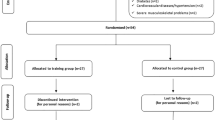Abstract
This study examined the effect of employee's participation in a physical fitness program in an industrial workplace on: job satisfaction, body image, and sickdays, using a pre-post matched control group design. Experimental and control groups (n's=23) were measured on the three dependent variables at the start of the fitness program and six months later. Analyses of covariance showed significantly higher job satisfaction, more positive body image, and fewer sickdays in the experimental group. Benefits of preventative health programs are discussed.
Similar content being viewed by others
References
Berry, C.A. (1981).Good health for employees and reduced health care costs for industry. Washington, D.C.: Health Insurance Association of America.
Brayfield, A.H., & Roth, H.F. (1951). An index of job satisfaction.Journal of Applied Psycology, 35, 307–311.
Brown, P. (1978). The realities of a fitness program in industry. Paper presented at aSymposium on Fitness in Industry in Pittsburgh, PA on March 22. Health Education Center of the Health and Welfare Planning Association.
Cohen, W.S. (1985). Health promotion in the workplace.American Psychologist, 40, 213–216.
Des Barres, J.P. (1982).A practical planning guide for employee health promotion programs. Madison, WI: The Health Planning Council, Inc.
Dublin, R. (1958).The world of work. Englewood Cliffs, NJ: Prentice Hall.
Edwards, M. A. (1978). Introductory remarks at aSymposium on Fitness in Industry in Pittsburgh, PA on March 22. Health Education Center of the Health and Welfare Planning Association.
Farrell, D., & Petersen, J.C. (1984). Commitment, absenteeism, and turnover of new employees: A longitudinal study.Human Relations, 37, 681–692.
Geannette, G. (1979). Inside the corporate gymnasium.American Way, 21–23.
Larry, R. H. (1978). Forward presented at aSymposium on Fitness in Industry in Pittsburgh, PA on March 22. Health Education Center of the Health and Welfare Planning Association.
Maryk, M. (1982). Corporate fitness and sports in a changing society.Joperd, 65, 64.
McGuinnis, J.M. (1985). Recent history of federal initiatives in prevention policy.American Psychologist, 40, 205–212.
Nash, J.D., & Ormiston, L.H. (1978).Taking charge of your weight and well-being. Palo Alto, CA: Bull Publishing Company.
Parkinson, R.S. (1982).Managing health promotion in the workplace. Palo Alto, CA: Mayfield Publishing Company.
Quinn, J. B. (1978).Medical insurance firms study cost-cutting plans. Washington Post, January 16.
Sehnert, K.W., & Tillotson, J.K. (1978).How business can promote good health for employees and their families. Washington, D.C.: National Chamber Foundation.
Author information
Authors and Affiliations
Rights and permissions
About this article
Cite this article
Der-Karabetian, A., Gebharbp, N. Effect of physical fitness program in the workplace. J Bus Psychol 1, 51–58 (1986). https://doi.org/10.1007/BF01014166
Issue Date:
DOI: https://doi.org/10.1007/BF01014166




